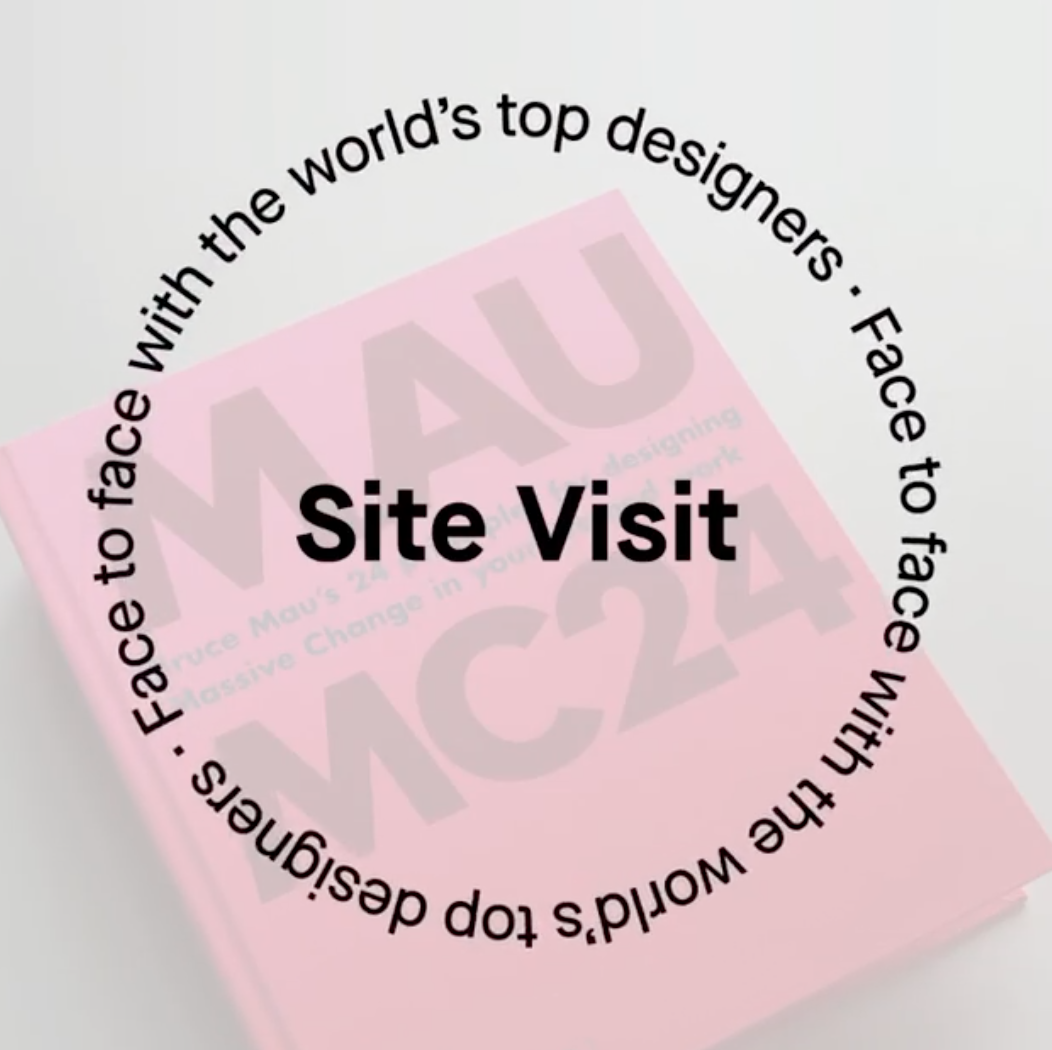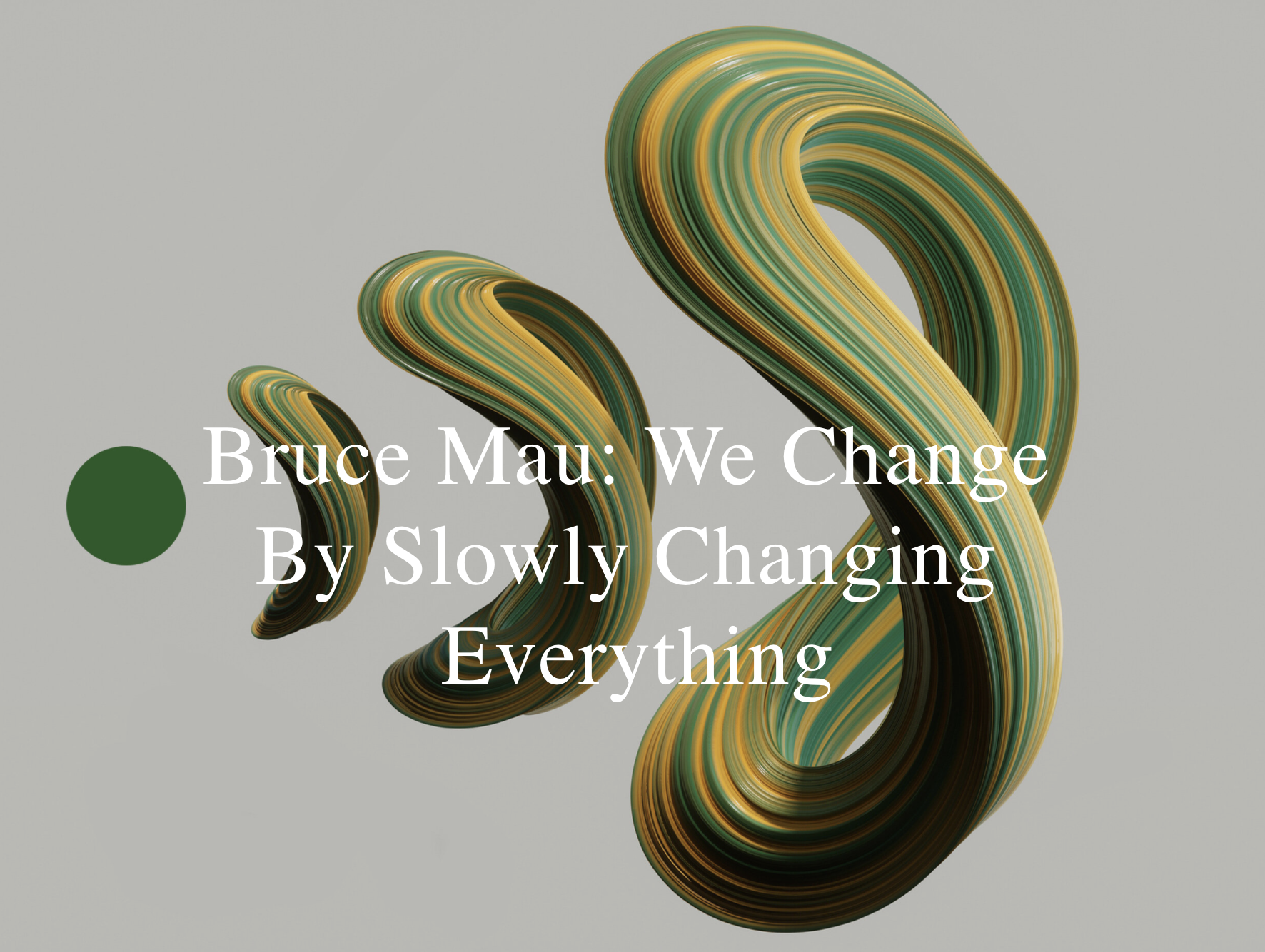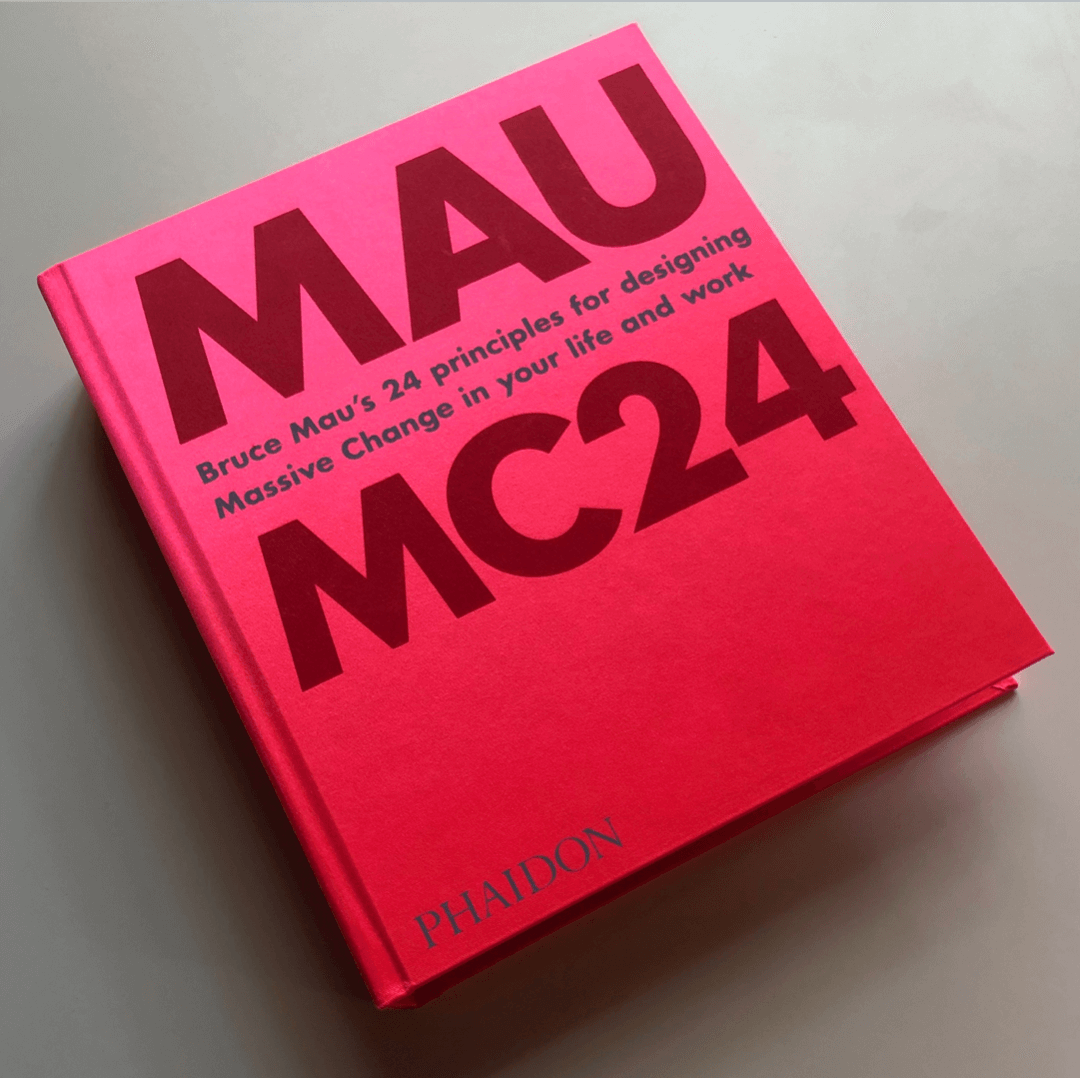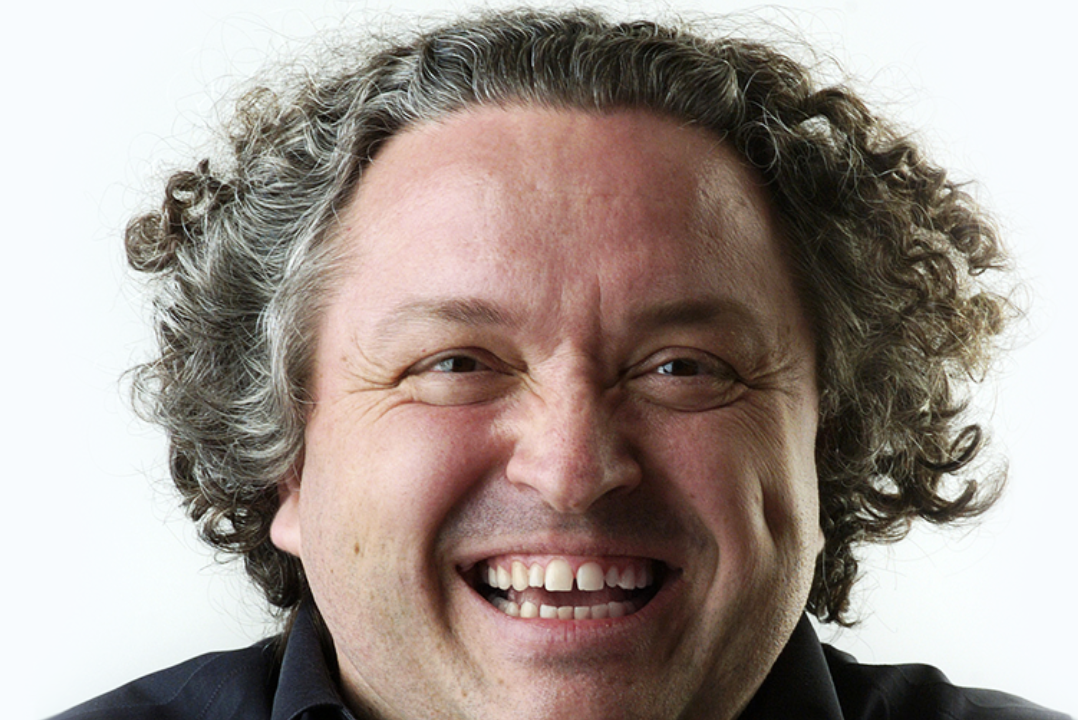Bruce Mau believes that far from being a hopeless case, the future of the planet is in safe hands. Mau, who is speaking at the Future of the Future presented with Spark Lab on August 15, told Charles Anderson how his philosophy of looking at the world as a design problem gives him optimism for the future.
The quote stuck with him – Bruce Mau had stumbled upon it in the dusty annals of history and he simply could not shake it. He discovered it in the work of historian Arnold Toynbee, who wrote in 1957 that “the twentieth century will be remembered chiefly, not as an age of political conflicts and technical inventions, but as an age in which human society dared to think of the health of the whole human race as a practical objective.”
It was the biggest idea that Mau had ever heard. It continues to inspire the Canadian designer, who co-founded the Massive Change Network, and is now the chief design officer for Freeman, one of the world’s top events and experiential marketing companies.
“Imagine saying that, having lived through World War II and the worst killing in human history,” Mau says.
Toynbee lived through the Blitz, through influenza epidemics, and the Great Depression. He covered wars for the Manchester Guardian and even interviewed Adolf Hitler in the mid-1930s who told Toynbee of his limited expansionist aims. Hitler convinced him. Toynbee lived through all that and thought no, this period in history will not be remembered as one of destruction or innovation, but as more of a design problem.
That idea was something that Mau, as a designer with decades of experience, believed that all fellow designers were committed to. He believed they committed to practical objectives and then figured out ways to get there.
“Designers think about the future and imagine a better one,” he says.
Toynbee’s quote dates back to 1957. Mau discovered it in the early 2000s. So, 50 years on, he set about trying to investigate whether the biggest idea he ever heard was true. The results surprised him. But they shouldn’t have.
“Not only is it true,” Mau says, “it is so radically true that it is staggering that we don’t believe it. It is shocking that it is not the dominant narrative of our time.”
That is why, partly, one of Mau’s recent projects tried to solve that very specific problem.

BRUCE MAU IS THE CHIEF DESIGN OFFICER FOR FREEMAN, THE WORLD’S LARGEST PRODUCERS OF LIVE EVENTS. PHOTO: SUPPLIED
Mau grew up on a farm outside of a mining town, six hours north of Toronto, Canada. It was a place where, in the winter, the temperature would drop to minus 40 degrees for weeks on end. He always loved playing with words and images but in those cold days his greatest concern was jumping on a snowmobile to get water from a well, some distance away, to bring back home. There was no running water in the winter.
“We had the last farm on the road to the northern wilderness,” he says. “There was nothing.”
Where he grew up the only places that men worked were in the smelter or the mines. The work was toxic. Men died young. But instead of following that path, Mau went to university. He failed. But before dropping out, his mind was opened.
“It provided everything a college should; it blew my mind, it introduced me to a new language, and I met a new group of people.”
Twenty-five years later that same university gave him an honorary doctorate. What Mau did in those 25 years was figure out the practice of design. This was beyond playing with words and images. This was about how to use those words and images for a purpose that tackled real problems.
“It is the practice of practicality,” he says. “Design shares a lot of cultural dimensions with art and it needs the emotional connection of art to succeed, but it begins and ends with metrics and impact. It is creativity and discipline.”
Mau was excited by this new discovery and started his career in Canada before arriving in London to work at a design company which had a variety of corporate projects on its books. He hated it.
“There was something false about it,” he says. “It wasn’t satisfying to me. There wasn’t any social ambition to the work.”
In London, Mau got involved in political action and participated in a huge protest against nuclear weapons. He found it one of the most emotional experiences he ever had.
“It made me think I had extraordinary power in creative work, and I can decide what that power is committed to. I can decide if it is committed to a world with greater access to sustainability and beauty, or I can use it for things that are oblivious to it.”
It was an epiphany that Mau summarises in one sentence: “I didn’t want to work that hard for shit I didn’t believe in.” He felt like, in doing meaningless work, he was designing the cage in which he was going to be caught it. So he moved back to Toronto and launched a company called Public Good. He started only doing work that he saw was making the world a better place. It was 1983, before the explosion of NGOs around the world, and Mau faced criticism for his new approach.
“The idea was a radical one at the time,” Mau says. “Designers were saying ‘who do you think you are, why do you think you can only work on things that you love?’ They thought it was a critique of them. I said, ‘I don’t care about you. I’m just interested in my work’.”
That work ended up taking him all over the world, writing and designing more than 200 books. He became known as a designer with a taste for solving big-picture problems for a vast range of clients that included art dealers, writers, academics, urban planners, product developers, entrepreneurs and architects such as Cesar Pelli and Frank Gehry.
It also led to his “Incomplete Manifesto for Growth,” a 43-point statement of his thinking on creative practice. It has been translated into more than 15 languages and shared widely on the internet for nearly 20 years.
“The manifesto was about how to sustain a creative life,” Mau says. “It’s not too difficult to be a hit designer for a season. The hard thing is to sustain a creative life over your lifetime.”
In it, he implores people to love their experiments regardless of how ugly they are, to go deep, to forget about ‘good’, to never enter awards and to never clean your desk (after all, you might find something in the morning that you couldn’t see at night). But he also advocates the power of organisation.
“Real innovation in design, or any other field, happens in context,” Mau writes. “That context is usually some form of cooperatively managed enterprise. Frank Gehry, for instance, was only able to realise the Guggenheim Museum in Bilbao because his studio could deliver it on budget. “The myth of a split between ‘creatives’ and ‘suits’ is what Leonard Cohen calls a ‘charming artefact of the past’.”
In Mau’s subsequent research, he found that companies that shrink this split, do away with that charming artefact, and put design as an executive function of their businesses outperformed the market by 224% over 10 years. “These aren’t start-ups, these are Coca Cola and IBM and Apple,” he says.
“If you took the design out of Apple, you would have a reasonably good tech company. But you put the design into Apple, you have the most valuable company in human history. I find it amazing that [people don’t] get it.”
Mau says the reason for this is partly down to education. In business, for the most part, design does not feature. Even in engineering, it is the same. Mau is currently a fellow of an engineering school, though he doesn’t really know anything about the craft. He says that is because those teaching the next generation of engineers see the value in having a creative angle to their work. Their questioning becomes more about ‘why’ they are trying to solve the problem and what they intend to accomplish.
“If you ask an engineer to build a bridge, they will focus on how thin they can make it,” Mau says. “If you ask a designer, the question is: ‘Why do we need a bridge? Maybe a boat would be better. Maybe going around the long way is better.

BRUCE MAU HOLDS A SESSION AS PART OF HIS WORK FOR MASSIVE CHANGE. PHOTO: SUPPLIED
This in itself is the long way of getting to Mau’s answers about the biggest idea he has ever heard. He wanted to change the conversation to focus on the reality – that, actually, the world is in a pretty good state. But how do you do that when humans are inherently tuned into the worst things that can happen?
“Genetically that is who we are – we focus an inordinate amount of our vigilance on bad things.”
So Mau tried to change the focus. The result was an unapologetically bold project that tried to examine the state of the world through the lens of Toynbee’s words. That formed the basis of one of the most ambitious exhibitions ever seen at the Vancouver Art Gallery. Massive Change filled 20,000 square feet of space over two floors of the building, where information about things that Mau felt should be the permanent context for human interaction screamed out from the walls. For example, the exhibition made it clear that, 200 years ago, 94% of the world lived on less than a dollar a day. Now that metric is less than 10%. Sure, there is a whole new class of problems, but Mau argues they are symptoms of success. We have climate change because we have 7.5 billion people in the world. The reason for that number is because we have reduced hunger and disease.
“The same is true in literacy, infant mortality, access to education, democracy – all the things that make the world a better place. We succeeded in solving so many problems. We met people who took smallpox off the face of the Earth. They used design to eradicate a disease forever – a disease that killed half a billion people in the 20th century and zero people in the 21st.”
Mau used graphics, text and objects to create an immersive experience to convey these ideas through an avalanche of information. The whole exhibition was prefaced by the question “Now that we can do anything, what will we do?”

PART OF BRUCE MAU’S MASSIVE CHANGE EXHIBITION THAT WAS FOCUSSED ON AN OPTIMISTIC, DESIGN- CENTRIC VISION OF THE WORLD. PHOTO: SUPPLIED
In solving humanity’s challenges Mau says we have a whole new class of ‘super problems.’
“That also makes them the greatest opportunities. Those that will solve these problems will create the greatest wealth in the history of mankind.”
Recently, in addition to his leadership of Massive Change Network, Mau took up the responsibility of chief design officer for Freeman, the world’s biggest producer of live events. One of his Freeman clients is the Institute of Food Technologists, through which he became involved in IFTNEXT, a think tank that is taking on the challenge to sustainably feed ten billion people.
“As a first step, we are creating a map of the global food system because, strangely, one doesn’t exist, and you can’t design what you can’t see.”
So yes, Mau is an optimist for the future. He says those that are not find it hard to comprehend that the challenges ahead of us won’t be solved with the tools that are behind us. He points to Ray Kurzweil’s observation that computers have been doubling in power from before transistors were even invented. By that calculation, it means that we will have the processing power of a human brain in our pockets for US$,1000 by 2025. By 2050 we will have access to processing powers of all human brains today for the same price.
“So, the tools that we will have to solve the problems that we have created are orders of magnitude more powerful than the tools that created them.”
Mau says he is not downplaying those challenges but has a designer’s answer for those that might be sceptical.
“We are working on it.”

PART OF BRUCE MAU’S WORK FOR FREEMAN, THE WORLD’S LARGEST PRODUCER OF LIVE EVENTS. PHOTO: SUPPLIED
Bruce Mau’s five hopes for the future
- I hope we change everything. Because we need new ways to do things, to do the things we love in perpetuity.
- I hope we clean up the mess that we created.
- I hope we can make smart things sexy so that people want to live the smart new way and reject the old stupid ways.
- I hope that we can come to terms with automation and the potential we have to eliminate all routine work. We have the potential to eliminate anything that is repetitive. That could be the best thing that ever happened to humankind but it means radically changing our notion of work and income.
- I hope to live long enough to see the global changes that we are working on.


















